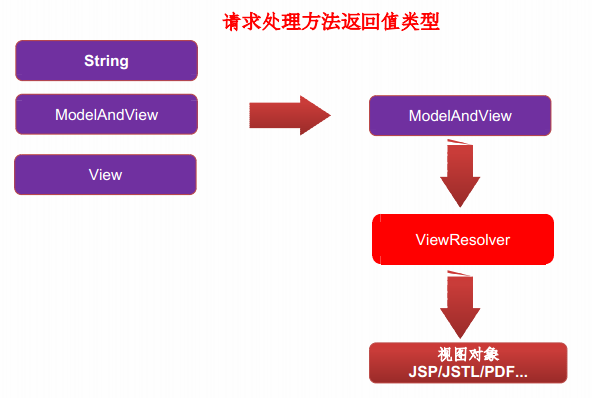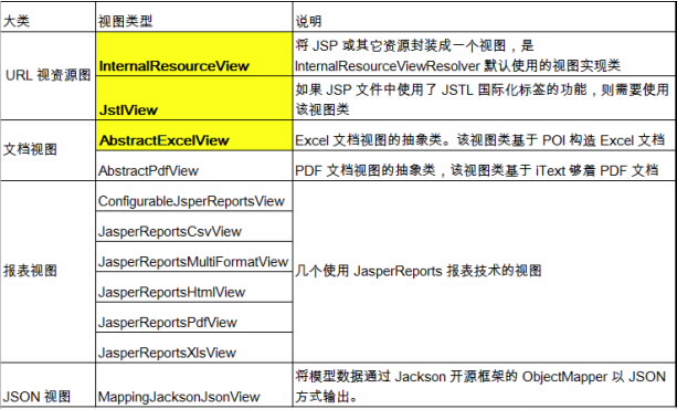SpringMVC是基於MVC設計理念的一款優秀的Web框架,是目前最流行的MVC框架之一,SpringMVC通過一套注解,讓POPJ成為處理請求的控制器,而無需實現任何接口,然後使用實現接口的控制器也完全沒問題;支持REST風格的URL請求;采用松散耦合架構,比其他MVC框架更具有靈活性和擴展性。關於SpringMVC工程如何搭建請點擊:Spring學習之第一個Spring MVC程序(IDEA開發環境)。
web.xml配置DispatcherServlet,DispatcherServlet默認會加載/WEB-INF/xxx-servlet.xml的Spring配置信息,啟動Web層的Spring容器。當然,也可以通過配置contextConfigLocation來自定義配置文件名稱和位置,如下所示:
<servlet>
<servlet-name>springmvc</servlet-name>
<servlet-class>org.springframework.web.servlet.DispatcherServlet</servlet-class>
<init-param>
<param-name>contextConfigLocation</param-name>
<param-value>/WEB-INF/springmvc-servlet.xml</param-value>
</init-param>
<load-on-startup>2</load-on-startup>
</servlet>
<servlet-mapping>
<servlet-name>springmvc</servlet-name>
<url-pattern>/</url-pattern>
</servlet-mapping>
xxx-servlet.xml中一般配置自動掃描的包信息、HandlerMapping、ViewResolver,如果沒有配置HandlerMapping,則默認使用的是BeanNameURLHandlerMapping;如果沒有配置ViewResolver,則默認使用的InternalResourceViewResolver。
<!-- 配置自定義掃描的包-->
<context:component-scan base-package="com.luoxn28"></context:component-scan>
<!-- ViewResolver 視圖解析器 如果沒有配置的話,則InternalResourceViewResolver就是默認的 -->
<bean class="org.springframework.web.servlet.view.InternalResourceViewResolver">
<property name="order" value="1"/> <!-- ViewResolver優先級 -->
<!-- 前綴 和 後綴 -->
<property name="prefix" value="/"/>
<property name="suffix" value=".jsp"/>
</bean>
SpringMVC中使用@RequestMapping注解為handler指定可以處理那些URL請求,該注解可以在方法及類定義處使用,DispatcherServlet處理請求時,通過handler的@RequestMapping提供的映射信息確定請求的處理類(或方法)。@RequestMapping在類和方法定義不同之處在於:
使用@RequestMapping示例如下所示:
@Controller
@RequestMapping("/test")
public class Test {
@RequestMapping("/testperson")
public String testUser(Person person) {
System.out.println(person);
return "index";
}
}
@RequestMapping 除了可以使用請求URL映射請求外,還可以使用請求方法、請求參數及請求頭映射請求,這些從@RequestMapping注解源碼也可以看得出來。@RequestMapping 的 value、method、params 及 heads分別表示請求 URL、請求方法、請求參數及請求頭的映射條件,他們之間是與的關系,聯合使用多個條件可讓請求映射更加精確化。
@RequestMapping(value = "/delete", method = RequestMethod.POST, params = "userId")
public String delete() {
// ...
return "xxx";
}
@RequestMapping(value = "/show", headers = "contentType=text/*")
public String show() {
// ...
return "xxx";
}
帶占位符的URL是Spring3.0之後新增的功能,該功能是SpringMVC向REST風格挺進發展一個重要標志。通過@PathVariable可以將URL中占位符參數綁定到控制器處理方法的入參中:URL 中的 {xxx} 占位符可以通過@PathVariable("xxx") 綁定到操作方法的入參中。
@RequestMapping("/delete/{id}")
public String delete(@PathVariable("id") Integer id) {
UserDao.delete(id);
return "index";
}
ps: 關於什麼是REST請翻到最後:finally REST部分。
在方法入參出使用@RequestParam把請求參數傳遞到方法中。-value是參數名,-requered是否必須,默認為true,表示如果該請求參數中不存在對應的參數,則拋出異常。
@RequestMapping("/userinfo")
public String getUserInfo(@RequestParam(value = "usrename", required = false) String username,
@RequestParam("age") int age) {
// ...
return "xxx";
}
請求頭包含了若干個屬性,服務器可據此獲知客戶端的信息,通過@RequestHeader即可將請求頭中的屬性值綁定到處理方法的入參中。
@RequestMapping("/hreaderinfo")
public String getUserInfo(@RequestHeader("Accept-Encoding") String encoding) {
// ...
return "xxx";
}
@RequestMapping("/sessioninfo")
public String getUserInfo(@CookieValue("sessionId") String sessionId) {
// ...
return "xxx";
}
Spring MVC 會按請求參數名和 POJO 屬性名進行自動匹配,自動為該對象填充屬性值。支持級聯屬性。
@RequestMapping("/personinfo")
public String getUserInfo(Person person) {
// ...
return "xxx";
}
當請求URL為 /personinfo?name=luoxn28&age=23 時,就會進行POPJ對象的填充,Person類如下所示:
public class Person {
String name;
int age;
// xxx
}
@RequestMapping("/servlet")
public String getUserInfo(HttpServletRequest request, HttpServletResponse response) {
// ...
return "xxx";
}
SpringMVC的handler方法可以接受HttpServletRequest/HttpServletResponse/HttpSession或者是java.security.Principal/Locale/InputStream/OutputStream/Reader/Writer類型的參數。
SpringMVC有幾種方式用於數據模型輸出,有ModelAndView、Map及Model、@SessionAttributes、@ModelAttribute等。
@RequestMapping("/model")
public String getUserInfo(Map<String, Object> map) {
map.put("time", new Date());
return "xxx";
}
@Controller
@RequestMapping("/test")
@SessionAttributes("time")
public class Test {
@RequestMapping("/session")
public String getUserInfo(Map<String, Object> map) {
map.put("time", new Date());
return "index";
}
}
當訪問url為 /test/session 時,會往服務器session中加入time屬性,其值為當前時間(new Date())。
@ModelAttribute
在方法定義上使用 @ModelAttribute 注解:Spring MVC在調用目標處理方法前,會先逐個調用在方法級上標注了@ModelAttribute 的方法。
在方法的入參前使用 @ModelAttribute 注解:
@Controller
@RequestMapping("/test")
@SessionAttributes("time")
public class Test {
/**
* 該方法會往隱含模型中添加一個名為time的模型數據
* 注意:同一個浏覽器同一段時間內,該函數只會被調用一次
*/
@ModelAttribute("time")
public Date getDate() {
Date time = new Date();
System.out.println("getDate -- " + time);
return time;
}
@RequestMapping("/model")
public String getUserInfo(@ModelAttribute("time") Date time, Map<String, Object> map) {
System.out.println(time);
map.put("date", new Date());
return "index";
}
}
如果在處理類定義處標注了@SessionAttributes(“xxx”),則嘗試從會話中獲取該屬性,並將其賦給該入參,然後再用請求消息填充該入參對象。如果在會話中找不到對應的屬性,則拋出 HttpSessionRequiredException 異常。
所以,為了避免發生異常,一般都會在請求到達handler方法前往數據模型(session域)中添加屬性,比如上面代碼中的public Date getDate()方法一樣。
SpringMVC是如何解析視圖的呢?在handler方法返回String、ModelAndView或者View後,都會被SpringMVC內部轉換為ModelAndView類型(如果handler方法為void類型的,則該方法自己負責數據渲染和返回結果)。
Spring MVC 借助視圖解析器(ViewResolver)得到最終的視圖對象(View),最終的視圖可以是 JSP ,也可能是Excel、JFreeChart 等各種表現形式的視圖。對於最終究竟采取何種視圖對象對模型數據進行渲染,handler並不關心,handler工作重點聚焦在生產模型數據的工作上,從而實現 MVC 的充分解耦。

視圖的作用是渲染模型數據,將模型裡的數據以某種形式呈現給客戶。SpringMVC中定義了一個View接口,源碼如下,視圖對象有視圖解析器負責實例化,是無狀態的,所以不會有線程安全問題。
public interface View {
String RESPONSE_STATUS_ATTRIBUTE = View.class.getName() + ".responseStatus";
String PATH_VARIABLES = View.class.getName() + ".pathVariables";
String SELECTED_CONTENT_TYPE = View.class.getName() + ".selectedContentType";
String getContentType();
void render(Map<String, ?> model, HttpServletRequest request, HttpServletResponse response) throws Exception;
}
常用的視圖實現類:

SpringMVC 為邏輯視圖名的解析提供了不同的策略,可以在 Spring WEB 上下文中配置一種或多種解析策略,並指定他們之間的先後順序。每一種映射策略對應一個具體的視圖解析器實現類。視圖解析器的作用比較單一:將邏輯視圖解析為一個具體的視圖對象。所有的視圖解析器都必須實現 ViewResolver 接口。常用的視圖解析器實現類如下所示:

可以選擇一種視圖解析器或混用多種視圖解析器,每個視圖解析器都實現了 Ordered 接口並開放出一個 order 屬性,可以通過 order 屬性指定解析器的優先順序,order 越小優先級越高。SpringMVC 會按視圖解析器順序的優先順序對邏輯視圖名進行解析,直到解析成功並返回視圖對象,否則將拋出 ServletException 異常。
InternalResourceViewResolver是最常用的視圖解析器,也是默認的視圖解析器,負責解析JSP視圖,使用方式如下所示:
<!-- ViewResolver 視圖解析器 如果沒有配置的話,則InternalResourceViewResolver就是默認的 -->
<bean class="org.springframework.web.servlet.view.InternalResourceViewResolver">
<property name="order" value="1"/> <!-- ViewResolver優先級 -->
<!-- 前綴 和 後綴 -->
<property name="prefix" value="/"/>
<property name="suffix" value=".jsp"/>
</bean>
一般情況下,控制器方法返回字符串類型的值會被當成邏輯視圖名處理。如果返回的字符串中帶 forward: 或 redirect: 前綴時,SpringMVC 會對他們進行特殊處理:將 forward: 和redirect: 當成指示符,其後的字符串作為 URL 來處理。
@RequestMapping("/forward")
public String getUserInfo(Map<String, Object> map) {
//...
return "redirect:index";
}
實現rest風格的增刪改查,增刪改查的對象是Person類,源碼如下:

顯示Person、刪除Person、更新Person頁面list.jsp源碼如下:

添加Person頁面post.jsp源碼如下:

Rest處理類源碼如下所示:
package com.luoxn28.rest;
import com.luoxn28.attribute.Person;
import org.springframework.stereotype.Controller;
import org.springframework.web.bind.annotation.PathVariable;
import org.springframework.web.bind.annotation.RequestMapping;
import org.springframework.web.bind.annotation.RequestMethod;
import java.util.Iterator;
import java.util.Map;
import java.util.Set;
@Controller
@RequestMapping("/rest")
public class Rest {
// 顯示所用Person
@RequestMapping("/persons")
public String persons(Map<String, Set<Person>> map) {
map.put("persons", Person.persons);
return "list";
}
// 添加Person
@RequestMapping(value = "/person", method = RequestMethod.POST)
public String personPost(Person person, Map<String, Set<Person>> map) {
Person.persons.add(person);
map.put("persons", Person.persons);
return "list";
}
// 刪除Person
@RequestMapping(value = "/person/{name}", method = RequestMethod.DELETE)
public String personDelete(@PathVariable("name") String name, Map<String, Set<Person>> map) {
Iterator<Person> iter = Person.persons.iterator();
while (iter.hasNext()) {
if (iter.next().getName().equals(name)) {
iter.remove();
System.out.println("刪除成功 " + name);
}
}
map.put("persons", Person.persons);
return "redirect:/rest/persons";
}
// 更新Person
@RequestMapping(value = "/person/{name}", method = RequestMethod.GET)
public String personUpdate(@PathVariable("name") String name, Map<String, Set<Person>> map) {
Iterator<Person> iter = Person.persons.iterator();
while (iter.hasNext()) {
Person person = iter.next();
if (person.getName().equals(name)) {
person.setAge(0);
System.out.println("更新成功 " + name);
}
}
map.put("persons", Person.persons);
return "redirect:/rest/persons";
}
}
REST:即 Representational State Transfer。(資源)表現層狀態轉化。是目前最流行的一種互聯網軟件架構。它結構清晰、符合標准、易於理解、擴展方便,所以正得到越來越多網站的采用。
資源(Resources):網絡上的一個實體,或者說是網絡上的一個具體信息。它可以是一段文本、一張圖片、一首歌曲、一種服務,總之就是一個具體的存在。可以用一個URI(統一資源定位符)指向它,每種資源對應一個特定的 URI 。要獲取這個資源,訪問它的URI就可以,因此 URI 即為每一個資源的獨一無二的識別符。
表現層(Representation):把資源具體呈現出來的形式,叫做它的表現層(Representation)。比如,文本可以用 txt 格式表現,也可以用 HTML 格式、XML 格式、JSON 格式表現,甚至可以采用二進制格式。
狀態轉化(State Transfer):每發出一個請求,就代表了客戶端和服務器的一次交互過程。HTTP協議,是一個無狀態協議,即所有的狀態都保存在服務器端。因此,如果客戶端想要操作服務器,必須通過某種手段,讓服務器端發生“狀態轉化”(State Transfer)。而這種轉化是建立在表現層之上的,所以就是 “表現層狀態轉化”。具體說,就是 HTTP 協議裡面,四個表示操作方式的動詞:GET、POST、PUT、DELETE。它們分別對應四種基本操作:GET 用來獲取資源,POST 用來新建資源,PUT 用來更新資源,DELETE 用來刪除資源。
參考資料:
1、尚硅谷SpringMVC學習視頻及資料
2、Spring學習之第一個Spring MVC程序(IDEA開發環境)